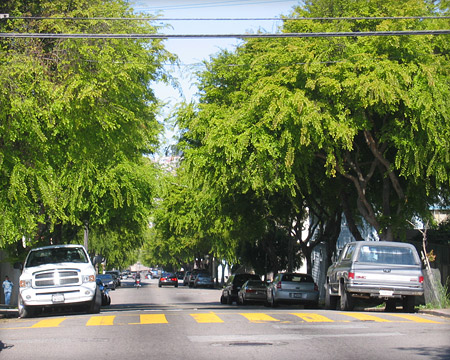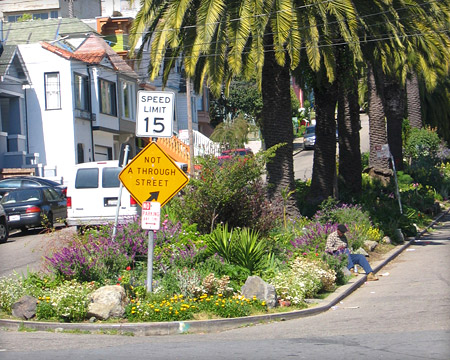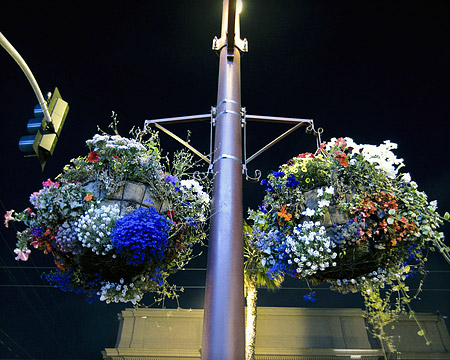San Francisco’s greening programs provide tools for individuals, business and community groups to participate in efforts to green and beautify the city’s streets. Street greening strengthens communities, improves public health, enhances our environment and increases the City’s economic resilience and vitality. Urban Greening topics covered by this website include all street and sidewalk landscaping in the public right-of-way, including trees, sidewalk and median landscaping, and above ground plantings.
- Hanging Planters
- Median Greening
- Parking Lane Planters
- Sidewalk Landscaping
- Street Trees
- Stormwater Overview
- Traffic Calming Overview
Benefits of Urban Greening
In addition to aesthetic benefits, urban greening also brings significant environmental, social, psychological, transportation and economic benefits to the city.
Environmental benefits
- Reduces stormwater runoff
- Reduces local air pollution
- Reduces greenhouse gas emissions
- Improves wildlife habitat
- Reduces the city’s carbon footprint by sequestering carbon from the atmosphere
Social/Psychological
- Reduces stress
- Tangible benefits in medical and academic settings when access to nature is provided
- Increases connection to nature and natural cycles (e.g. through access to planting and wildlife)
- Provides places to gather, increasing interactivity between neighbors
- Gives visitors a sense that the street is cared for and maintained
Transportation/Economic
- Increases property values in residential areas
- Increases amount of time and money spent in commercial districts
- Slows traffic, increasing pedestrian comfort and safety
- Beautifies streets, making them more inviting for walking
Process Overview
San Francisco has several programs and permits designed to facilitate residents and/or community groups in adding green space to their neighborhood streets.
For sidewalk landscaping and street trees, the process is relatively straightforward. These streetscape elements have simplified permits and can be implemented by individual property owners as well as community groups. Community members are encouraged to work with their neighbors to enhance the project and reduce construction costs through improved economies of scale.
Median greening and hanging planters generally involve greater neighborhood outreach and a more complex process, and are typically carried out by a neighborhood or business organization. Project sponsors are encouraged to speak with a DPW permit specialist early in the process to map out a permitting strategy for these projects.
See Building Neighborhood Support
The City’s stormwater management and traffic calming programs also provide significant opportunities for urban greening. The level of community input and permitting processes for these projects varies depending on the scope and scale of each project
To learn more about the city’s permitting process see, See Permit Process.
See individual urban greening feature pages for more information about each specific project type.
Official Codes & Documents
- Planning Code requirements
(Section 138.1 of the San Francisco Planning Code) - Stormwater Ordinance
(Article 4.2 of the San Francisco Public Works Code) - Urban Forestry Ordinance
(Article 16 of the San Francisco Public Works Code) - Green Building Ordinance
(Chapter 13C of the San Francisco Building Code) - Better Streets Plan
(comprehensive guidelines for the design of streetscape and pedestrian elements) - Stormwater Design Guidelines
(guidelines for design of low-impact development stormwater management features) - Water Efficient Irrigation Ordinance
(Chapter 63 of the Administrative Code)
Design Guidelines
See individual urban greening feature pages for element-specific design guidelines.
General Urban Greening Guidelines
Selecting Plant Types
Street trees and other landscaping should be used to create a distinct character for specific streets and neighborhoods. Trees and landscaping should be designed in harmony with street lighting and sidewalk amenities and the building context. Trees and plants vary in their aesthetic appearance due to variations in form, texture, foliar density/visual permeability, seasonal presence of flowers, seasonal color, bark characteristics, and persistence of leaves (evergreen vs. deciduous).
Aesthetic appearance should be taken into account in making design decisions for the public right-of-way. New planting added to existing streets should be in visual harmony with existing trees and planting. Selection of planting material should be used to enhance the identity of streets important to the city pattern.
In view of global climate change, consideration should be given to future watering needs and heat resistance of species selected for planting. Landscape practices should follow xeriscape principles and drought-tolerant species should be used to meet the increased dryness associated with the anticipated future climate of San Francisco, and are required in some instances per the City’s Water Efficient Irrigation Ordinance.
If initial or ongoing irrigation is needed, the project should have access to a metered water source and seek approval from the account holder to use the water service. If the meter is a mixed use meter (i.e. also serves a home or business), the landscape project must be under 5,000 square feet. Otherwise, dedicated irrigation meters are required for landscape projects over 5,000 square feet per the Water Efficient Irrigation Ordinance. Contact SFPUC Customer Service to locate water service account information.
Plant material selection should account for performance in the urban environment, including drought tolerance and hardiness. Unfortunately, many native species do not do well in harsh urban conditions. Any plant species selected for planting should be adapted to soil and microclimate conditions and should serve an intended functional or aesthetic role.
In some cases, the drought tolerant character of some native species may make them particularly suited for planting; however, past performance of the species in terms of durability, longevity, wind resistance, and high branching to provide line-of-sight for pedestrians and vehicles should also be considered.
Native plants and trees should be considered when a native species is suited to the site and will serve the roles for which the planting is intended. They should also be considered for stormwater plantings, areas of habitat value or connections, or for educational purposes.
Evergreen tree species should be used where it is desired to maintain foliage through the winter months or to enhance ecological performance by allowing leaves to slow stormwater during the rainier season. Deciduous trees should be considered for their ability to allow sunlight in the winter months.
Climate and Soil
Placement of trees and landscaping should reflect an understanding of local soil and climate conditions.
DPW has developed a list of recommended trees for different San Francisco environments have been in relation to the environment identified in the microclimates map. Check with DPW before planting to confirm that the preferred species is suitable for your particular site conditions.
Approved Street Tree List (DPW)
Before planting, current soil conditions should be evaluated and the soil amended to create the most beneficial growing conditions for trees and landscaping. Mulches should be considered to reduce erosion and decrease soil desiccation.
Other Considerations
Stormwater management: the design of planting areas should consider including appropriate conditions for improved stormwater detention and infiltration.
Reuse of underused street space: Many spaces that occur within the public right-of-way may be considered for trees and other plantings. These spaces include traffic circles, excess space where two street grids intersect, parking lane planters, and other unique spaces. In some cases, small groves of trees may be planted in these reclaimed species at a greater density than would be typically possible for street trees.
Culturally-sensitive plantings: The variety of cultural backgrounds of the people living in San Francisco should be considered in the selection and planting of trees in certain neighborhoods and adjacent to particular civic buildings. For example, in neighborhoods with a relatively high density of residents of Chinese descent, tree plantings might adhere to the principles of ’feng shui’. Other ethnic groups place particular value on certain tree species and would like to see them planted in their neighborhoods.
Outreach to different cultural groups should be incorporated into site specific plans for tree planting in the public right-of-way.
Urban forest as habitat: A variety of native and exotic wildlife species make use of trees and landscaping in the city. Trees and landscaping provide cover, nesting sites, food, and a source of water. Street trees and landscaping provide corridors for the movement of many species and serve as important links between parks and open spaces throughout the city. Future tree planting and street landscaping projects should consider existing linkages between parks currently provided by street trees and address gaps by locating new plantings in a supportive way.
Personal security:Personal security of people using the public right-of-way is influenced by trees and other plantings. Trees and shrubs that do not obstruct views, interfere with street and pedestrian lighting, or block potential escape routes enhance personal security. Trees and shrubs should be pruned and maintained to ensure good street level visibility and avoidance of interference with street and pedestrian lighting. Street lighting should also be installed with tree locations in mind. Box hedges over 3 feet in height should be avoided, as they may obscure visibility or constrict paths of travel.
Maintenance
With some exceptions, fronting property owners are responsible for the on-going maintenance and upkeep of sidewalk paving as well as all sidewalk elements directly fronting their property, such as trees, landscaping, and street furniture. Generally, the City is responsible to maintain roadway paving and other features in the roadway, such as medians.
Typically, if you initiate street or sidewalk improvements, you will be responsible for maintenance of those features. Specific requirements will be described in your permit.
For a more detailed description of maintenance responsibilities, see Maintenance, or see individual urban greening feature pages.










 Copyright © 2015
Copyright © 2015